Abstract
H Syndrome is a rare genodermatosis. It may include facial involvement such as: facial telangiectasia, both hypo‐ and hyperpigmented lesions, hirsutism, swollen cheeks due to subcutaneous infiltration and eczematous lesions. We describe a new facial phenotype with dermoscopic and histological features in the spectrum of non‐Langerhans cell histiocytosis.
Keywords: dermoscopy, facial lesions, H Syndrome, non‐Langerhans cell histiocytosis
H Syndrome is an autosomal recessive genodermatosis due to mutation in SLC29A3 with multisystem involvement. Hyperpigmentation, hypertrichosis, and skin induration can involve lower limbs but also other parts of the body including the face. Erythematous, annular, slightly keratotic, and figurate lesions in cheeks and nose represent a new clinical feature.

1. INTRODUCTION
H Syndrome is an autosomal recessive genodermatosis due to mutation in SLC29A3 with multisystem involvement. Skin lesions are characteristic, with hyperpigmentation, hypertrichosis, and progressive skin sclerosis of the lower part of the body. We report a new skin manifestation in the face of a young girl with H Syndrome.
2. CASE REPORT
A 12‐year‐old girl, born from consanguineous marriage, was presented with a five‐year progressing bilateral, symmetrical, hyperpigmented, and thickened patches with hypertrichosis. These lesions were present not only in the inner thighs but also in pubic and lumbar regions. On examination, she has gluteal lipodystrophy, swelling with hyperpigmentation of labia majora as well as finger and toe flexion contracture (camptodactyly and hallux valgus), and deformation of teeth (Figure 1). Erythematous, annular, and figurate lesions slightly keratotic without atrophy were present in cheeks and nose (Figure 2). Dermoscopy revealed multiple telangiectasias drawing a reticulated network (Figure 3). A four‐mm punch biopsy showed perifollicular focal para‐keratotic hyperkeratosis of the epidermis. The dermis was slightly edematous and contain ectatic capillaries. There was a lymphocytic and histiocytic infiltrate (Figure 4). IHC was positive for CD68 (Figure 5). The diagnoses of a mycological cause, porokeratosis of Mibelli, and sub‐acute lupus erythematous were excluded. She has also been explored for hearing loss in the early childhood with hearing aids. Ophthalmological examination showed chorioretinal atrophy. Biological data showed low hemoglobin (9.5 g/dL) and high erythrocyte sedimentation rate (75 mm/h). The rest of laboratory tests including thyroid function tests, lipid profile, liver function tests, renal function tests, and antinuclear antibodies profile were all normal. Echocardiography and electrocardiogram were normal. Abdominal ultrasound found small uterus and ovaries with thickened skin and subcutis of vulva. Genetic analysis revealed homozygous missense mutation c.1088G>A; p.Arg363GIn in exon 6 in linkage disequilibrium with the same non‐pathogenic variant at intron 2 c.300+3A>G. H Syndrome was diagnosed based on histological, immunohistochemical (IHC) examination and molecular analysis. The unusual feature of this case of H Syndrome was the presence of erythematous annular and figurate lesions that were slightly keratotic in cheeks and nose, thus representing a new clinical feature of H Syndrome.
FIGURE 1.
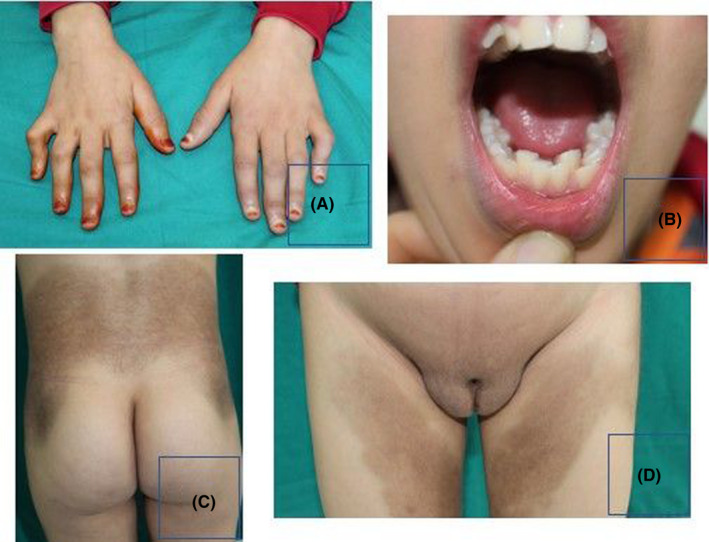
(A): Finger flexion contracture (camptodactyly) (B): Deformation and disorganization of teeth; (C), (D): Symmetrical, hyperpigmented, and thickened patches with hypertrichosis in the inner thighs, pubic, and lumbar regions
FIGURE 2.
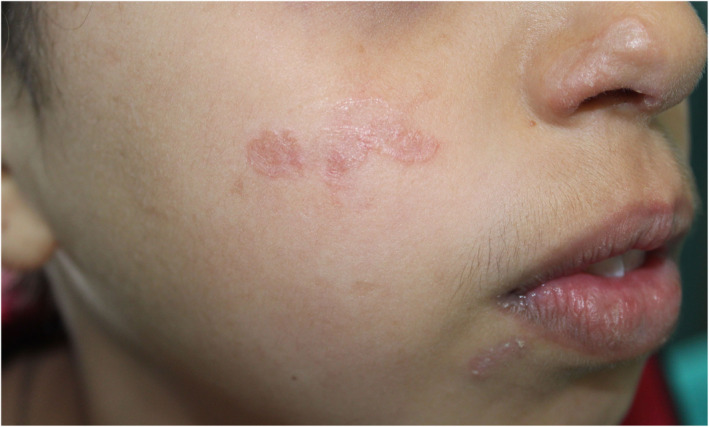
Erythematous, annular, and figurate lesions slightly keratotic without atrophy in cheeks and nose
FIGURE 3.
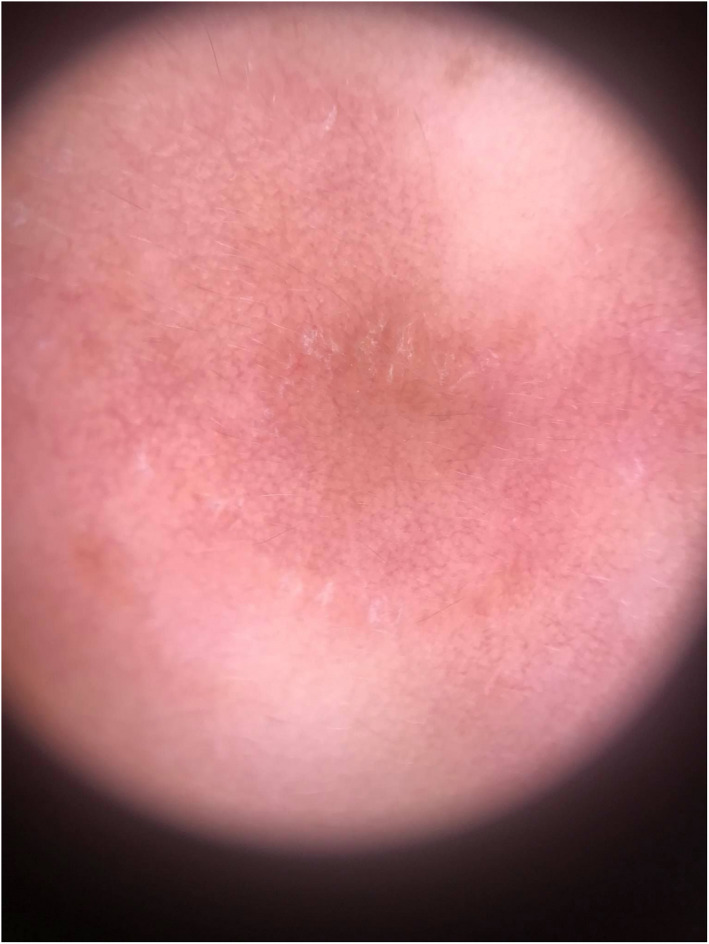
Dermoscopic image showing multiple telangiectasias drawing a reticulated network
FIGURE 4.
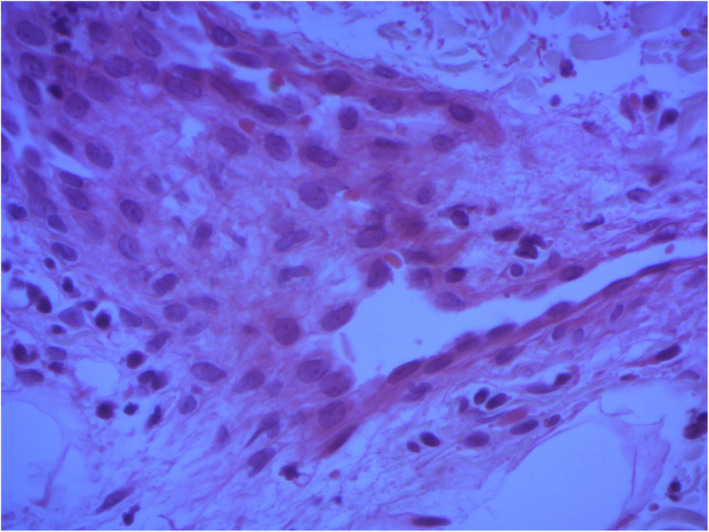
Lymphocytic and perivascular histiocytic infiltrate of the dermis (HE ×400)
FIGURE 5.
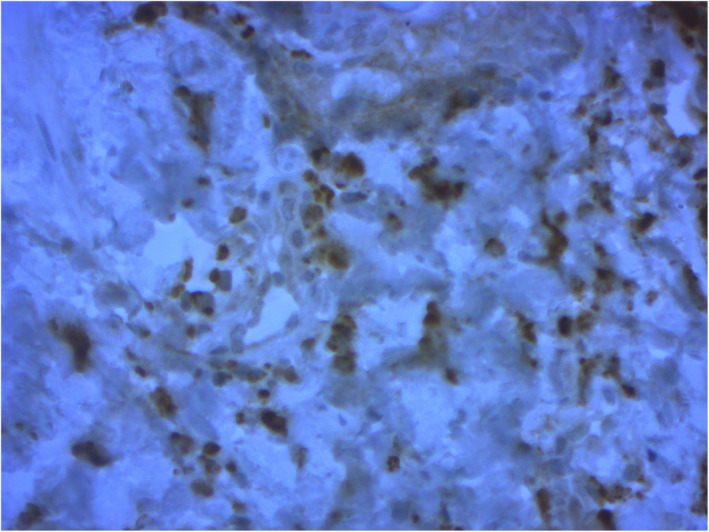
Anti‐CD68 immunostaining revealing the presence of numerous perivascular histiocytes (CD68 ×200)
3. DISCUSSION
A wide range of cutaneous lesions was reported in patients with H Syndrome. Based on increased CD68+ histiocytes, this syndrome is considered as a histiocytic disorder (non‐Langerhans cell histiocytosis). 1 , 2 The most common are hyperpigmentation, hypertrichosis, and skin induration involving especially lower limbs but also other parts of the body including the face. 3 , 4 Authors described less common facial manifestations. These features include facial telangiectasia 2 , 4 , 5 both hypo‐ and hyperpigmented lesions, 6 hirsutism, 1 swollen cheeks due to subcutaneous infiltration 4 and eczematous lesions. 1
Our case is particular. The girl had not only classic features of H Syndrome but also additional manifestations. To our knowledge, annular keratotic and figurate lesions of the face have not been described before. The histiocyte CD68+ infiltrate indicates a novel phenotype of the same pathologic process. Our patient presented gluteal lipodystrophy with cutaneous and subcutaneous thickening which is a less frequent feature in this syndrome. 4 The reduced size of uterus and ovaries may be secondary to the deep histiocyte infiltrate. Chorioretinal atrophy is also an unusual ophthalmological abnormality.
4. CONCLUSION
H Syndrome is a rare genodermatosis and approximately 100 cases have been reported in the world so far. We describe a new facial phenotype with dermoscopic and histological features in the spectrum of non‐Langerhans cell histiocytosis.
AUTHOR CONTRIBUTION
RM and BM wrote the manuscript. BE and SK revised the manuscript. CS and BT wrote parts of the manuscript related to the histopathological aspects of the disease. RM, BE, SK, and TH contributed to the management of the patient and revised the article. CH wrote parts of the manuscript related to genetics. TH critically reviewed the manuscript and gave final approval. All authors have read and approved the final manuscript and agree to take full responsibility for the integrity and accuracy of the work.
CONFLICT OF INTEREST
None.
CONSENT
Obtained from the patient to publish this report in accordance with the journal's patient consent policy.
ETHICAL APPROVAL
The authors declare that this article follows the policies of Solid State Ionics as outlined in the Guide for Authors and in the Ethical Statement.
ACKNOWLEDGMENT
None.
Rekik M, Bahloul E, Ben Rejeb M, et al. Unusual facial lesions in H syndrome. Clin Case Rep. 2022;10:e06098. doi: 10.1002/ccr3.6098
REFERENCES
- 1. Bloom JL, Lin C, Imundo L, et al. H syndrome: 5 new cases from the United States with novel features and responses to therapy. Pediatr Rheumatol Online J. 2017;15(1):76. [DOI] [PMC free article] [PubMed] [Google Scholar]
- 2. Tekin B, Atay Z, Ergun T, et al. H syndrome: a multifaceted histiocytic disorder with hyperpigmentation and hypertrichosis. Acta Derm Venereol. 2015;95(8):1021‐1023. [DOI] [PubMed] [Google Scholar]
- 3. Priya TP, Philip N, Molho‐Pessach V, Busa T, Dalal A, Zlotogorski A. H syndrome: novel and recurrent mutations in SLC29A3. Br J Dermatol. 2010;162(5):1132‐1134. [DOI] [PubMed] [Google Scholar]
- 4. Molho‐Pessach V, Ramot Y, Camille F, et al. H syndrome: the first 79 patients. J Am Acad Dermatol. 2014;70(1):80‐88. [DOI] [PubMed] [Google Scholar]
- 5. Mohanan S, Chandrashekar L, Semple RK, et al. H syndrome with a novel homozygous R134C mutation in SLC29A3 gene. Int J Dermatol. 2013;52(7):820‐823. [DOI] [PubMed] [Google Scholar]
- 6. Al‐Hamdi KI, Ismael DK, Qais SA. H syndrome with possible new phenotypes. JAAD Case Rep. 2019;5(4):355‐357. [DOI] [PMC free article] [PubMed] [Google Scholar]


